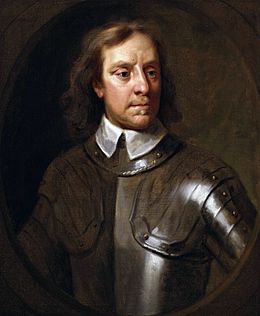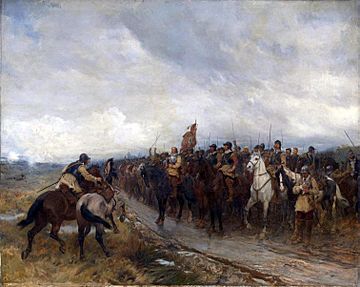Battle of Inverkeithing facts for kids
The Battle of Inverkeithing was a fight on 20 July 1651 between an English army led by John Lambert and a Scottish army led by James Holborne. It happened near Inverkeithing, Scotland. This battle was part of the English invasion of Scotland during the Third English Civil War.
Quick facts for kids Battle of Inverkeithing |
|||||||
|---|---|---|---|---|---|---|---|
| Part of the Wars of the Three Kingdoms | |||||||
|
|||||||
| Belligerents | |||||||
| Commanders and leaders | |||||||
| James Holborne | John Lambert | ||||||
| Strength | |||||||
| More than 4,000 | 4,000 | ||||||
| Casualties and losses | |||||||
| 800 killed 1,000 captured |
8 killed Unknown number wounded |
||||||
| Official name | Battle of Inverkeithing II | ||||||
| Designated | 30 November 2011 | ||||||
| Reference no. | BTL23 | ||||||
Why did the war start?
Kings and Parliaments
In the 1600s, England and Scotland were separate kingdoms. But they shared the same king, Charles I. This was called a personal union. Charles I believed he had the right to rule without much input from Parliament.
Charles I and the Covenanters
Charles I tried to change the Church of Scotland (called the Kirk) to be more like the English church. The Scots did not like this. They formed a group called the Covenanters. They signed a special agreement, the National Covenant, to protect their church. This led to wars between Charles I and the Scots, called the Bishops' Wars. Charles I lost these wars.
The English Civil War begins
After the Bishops' Wars, Charles I also had problems with the Parliament of England. This led to the First English Civil War in 1642. Charles I's supporters were called Royalists. They fought against the Parliamentarians (called Roundheads) and the Scots. The Scots joined the English Parliamentarians in an alliance.
After four years, the Royalists lost. Charles I gave himself up to the Scots. Later, the Scots handed him over to the English Parliament. Charles I then made a secret deal with the Scots. He promised to accept their church rules in England for three years if they helped him get his throne back.
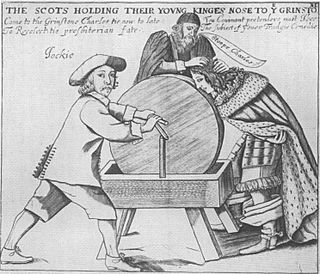
Charles I's execution and Charles II's return
In 1648, another war broke out in England. The Scots sent an army to help Charles I, but they were defeated. The English Parliament's army, led by Oliver Cromwell, took control. They put Charles I on trial for treason. He was executed on 30 January 1649. England then became a republic, called the Commonwealth of England.
The Scottish Parliament was angry about Charles I's execution. They declared his son, Charles II, king of both Britain and Ireland. But they made Charles II promise to follow their church rules before he could return from exile. Charles II agreed to these terms in May 1650. He then sailed to Scotland.
Who fought in the battle?
Soldiers and their weapons
Both armies had similar types of soldiers and weapons. The main fighting units were called regiments. Each regiment had two types of soldiers:
- Musketeers: These soldiers used muskets, which were long guns. They used a special slow-burning rope (called a slow match) to fire their weapons.
- Pikemen: These soldiers carried long wooden poles with steel points, called pikes. These pikes were about 15 feet (4.6 m) long. Pikemen also carried swords and wore steel helmets.
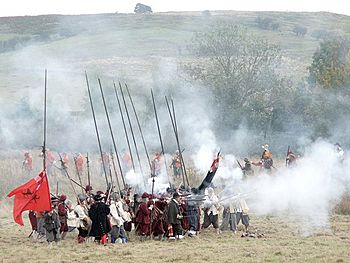
Infantry regiments were often grouped into brigades. Soldiers would stand close together in rows, with pikemen in the middle and musketeers on the sides. Musketeers would fire their guns, and then the pikemen would charge forward to break the enemy lines.
Cavalry: Horse power!
Cavalry soldiers rode horses. English cavalry rode large horses. They wore metal lobster-tailed pot helmets and thick leather jackets. They carried two pistols and a sword. Their pistols were not very accurate from far away.
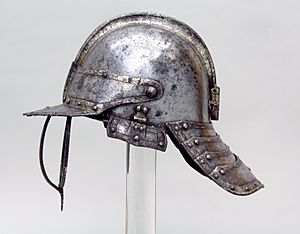
Scottish cavalry had similar gear, but their horses were smaller and lighter. This made them faster and more agile. English cavalry liked to charge in tight groups, using the weight of their horses to break through enemy lines. Scottish cavalry preferred quick attacks and then retreating.
Dragoons: Mounted fighters
Both armies also had dragoons. These soldiers could ride horses quickly to move around, but they would often get off their horses to fight. English dragoons used shorter muskets called carbines or pistols. Scottish dragoons used muskets and swords. Dragoons were often used for scouting or protecting the back of the army.
How did the battle happen?
England invades Scotland
The English Commonwealth felt threatened by Scotland rearming. So, Oliver Cromwell, the new commander of the English army, led his troops into Scotland on 22 July 1650. This started the Third English Civil War.
The Scottish army was led by David Leslie. Many experienced soldiers had been removed from the Scottish army because of political disagreements. This meant many new, untrained recruits were fighting. Leslie set up defenses near Edinburgh and used a "scorched earth" tactic, destroying supplies so the English couldn't use them.
Cromwell tried to get the Scots to fight near Edinburgh, but Leslie avoided battle. The Scots also removed more officers and soldiers from their army, weakening it further.
The Battle of Dunbar
On 31 August, Cromwell's army moved to Dunbar. The Scottish army blocked their way to England. Leslie moved his army down from a strong hill to attack Dunbar. But on the night of 2/3 September, Cromwell launched a surprise attack on the Scottish army.
The Scots were caught off guard. Their cavalry was pushed back. Many of Leslie's infantry couldn't even join the fight because of the difficult land. Cromwell led his cavalry reserve and defeated the Scottish lines. About 6,000 Scots were captured, and 1,500 were killed or wounded.
After this big defeat, many people fled Edinburgh. Leslie tried to resign, but the Scottish government wouldn't let him. He tried to build a new defense line at Stirling, a narrow passage that blocked access to northern Scotland. Cromwell captured Edinburgh and its port, Leith.
Moving towards Inverkeithing
For months, the English tried to get past Stirling or force the Scots into another battle, but they failed. Charles II was officially crowned king in Scotland on 1 January 1651. The Scottish government also started bringing back some of the experienced soldiers they had removed earlier.
In January 1651, the English tried to cross the Firth of Forth (a large river mouth) to get around Stirling, but it didn't work. In late June, the Scottish army moved south. Cromwell tried to attack them, but Leslie kept his army in strong defensive positions.
Crossing the Forth River
In June 1651, the English built 50 flat-bottomed boats. On 17 July, about 1,600 English soldiers crossed the Firth of Forth at its narrowest point. They landed at North Queensferry on the Ferry Peninsula. The Scots sent troops to stop them and called for more soldiers. Over the next four days, more English troops crossed, and Major-general John Lambert took command.
By the morning of 20 July, the English had about 4,000 soldiers. The Scots also had over 4,000 men. These included three infantry regiments, 500 Highlanders, and several cavalry units.
The battle begins
The Ferry Peninsula is a narrow piece of land. On 20 July, the Scots moved towards the English. The Scottish commander, Holborne, thought the English had more soldiers, so he ordered his men to pull back. Lambert, thinking he had more men, sent cavalry to bother the Scottish rear. Holborne then turned his army to face the English on a hill.

The battle details are not fully clear. The Scottish infantry was in the middle, with cavalry on their right and Highlanders on their left. The English also had infantry in the center, with cavalry on both sides. For about an hour and a half, neither side attacked. Then, Lambert heard that more Scottish soldiers were coming. He decided to attack.
The Scottish cavalry on the right side charged and pushed back some English cavalry. But the Scots had no reserve troops to follow up. The English, who had kept a reserve, counter-charged and defeated the Scottish cavalry. Their commander, Browne, was captured and later died. The same thing happened on the other side. The Scots were initially successful but were then defeated by the English reserve cavalry. This part of the battle was over in less than 30 minutes.
The Scottish infantry tried to retreat. The English cavalry chased them for about 6 miles (10 km). Two Scottish regiments escaped, but one regiment and the Highlanders were wiped out. Many were captured, and the Highlander leader, Duart, was killed. Holborne escaped.
Lambert claimed that 2,000 Scots were killed and 1,400 captured. He said only 8 English soldiers were killed. Other sources suggest about 800 Scots were killed and 1,000 captured.
What happened after the battle?
Capturing key Scottish towns
After the battle, Lambert captured the port of Burntisland. Cromwell then moved most of his army there, gathering 13,000 to 14,000 men by 26 July. Cromwell then marched on Perth, which was the temporary seat of the Scottish government. Perth surrendered after two days. This cut off the Scottish army from supplies and new soldiers.
Charles II and Leslie saw no hope of winning if they stayed. So, they marched south and invaded England, hoping to start a Royalist uprising there. Cromwell and Lambert followed them. General George Monck was left with 6,000 men to finish off the remaining Scottish resistance.
By the end of August, Monck had captured Stirling and other towns. Dundee was one of the last major Scottish strongholds. Monck demanded its surrender. The governor refused, believing the town walls were strong enough. Monck's troops stormed Dundee on 1 September and thoroughly sacked it. Many civilians, including women and children, were killed. After hearing this news, Aberdeen quickly surrendered. This ended most Scottish resistance.
The end of the war
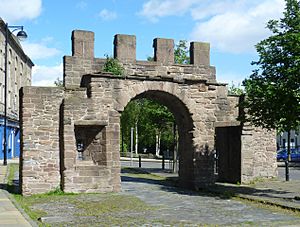
Cromwell's forces caught up with the Scottish army at Worcester in England. On 3 September 1651, they defeated them at the Battle of Worcester. Leslie and most of the Royalist commanders were captured. Charles II managed to escape.
The Scottish Covenanter government was removed, and the English took control. After Cromwell died in 1658, there was political confusion. Eventually, General Monck led his army to London in 1660. A new Parliament invited Charles II to return as king of both England and Scotland. Scotland and England officially united as one nation in 1707.


